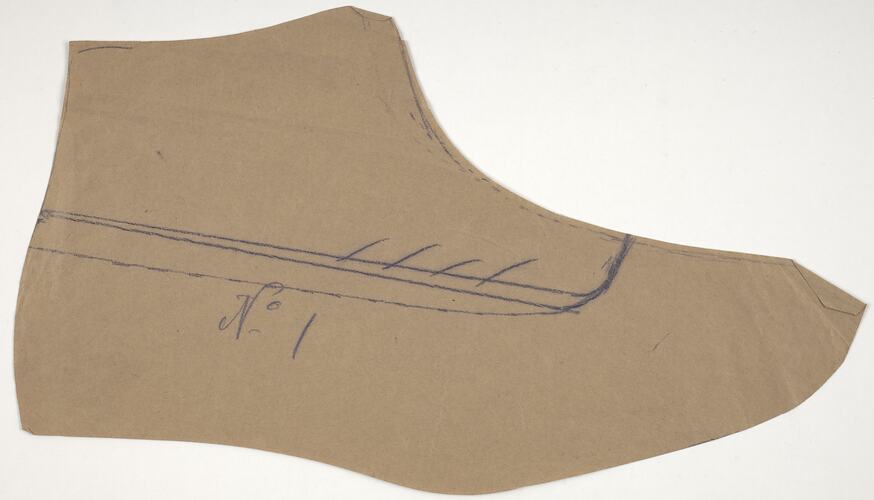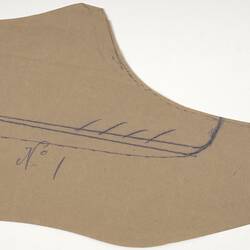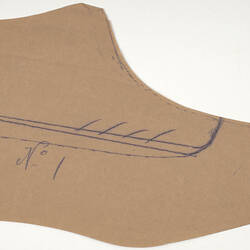Summary
Created on brown paper, this flat soled boot pattern with its various markings suggest this is a generic pattern format most likely used by Stanio Fancoff in the creating of his various shoe styles sometime between the 1930s and 1970s. Amongst many others, this pattern is part of the shoemaking designer kit that enabled Stanio to acquire versatility and different fashions within his shoemaking trade.
Stanio Ivanoff Fancoff was born in 1908 in Bojentsi, a small village in Bulgaria. At age 11, Stanio left home to learn the shoemaking trade. In 1929, he immigrated to Melbourne, settled in Fitzroy and began to work for the V.G. Zemancheff & Sons basket shoe factory in South Melbourne. In1936, he married Dorotea Georgi Touzou who had recently arrived in Australia. Around this time, Stanio set up his own shoemaking business from home, with Georgi, her cousin and sister weaving the shoes which he then assembled. Select shoe samples were then taken to Sydney and Tasmania for sale. In 1942, Georgi and Stanio moved to Broken Hill for Georgi's health; there daughter Nancy was born and Stanio set up a shoe shop/factory. In 1945, Georgi died and by 1950 Stanio and Nancy had moved to Adelaide where he again opened a shoemaking business and shop. He passed away in 1978, having been in the shoemaking business for 59 years. This collection documents his migration and working life experiences.
Physical Description
Drawn within a side-view perspective the boot's toe faces right. This pattern's shape visuallly references a ankle height flat based boot. Generated on brown paper this pattern has several pencil markings. First markings are located midway within the pattern's horizontal plane and appears as three ruled lines that slightly descend (approximately 4 degrees) from shoe back to front and intersect at the three-quarter across point with a vertically line, that has descended from the boot's vamp topline. In addition, located within the first upper ruled line's right hand portion are four short diagonal marks that ascend from left to right. Located within the boot's tongue, vamp and toe box upper areas is a singular line that parallels the shoe's edge. Written within cursive script the inscription "No1" is positioned central to the boot's frame. Although the pattern appears in good condition, the paper has been folded (possibly through time or incorrect storage) on both the toe cap and the top upper point.
Significance
This collection is significant in documenting a small migrant business as well as the fashion of a particular period. It is well provenanced and charts the application of trade skills in a new country. It also illustrates the stages of hand shoe manufacture from the 1930s, demonstrating the enduring nature of the tools and patterns that were used.
More Information
-
Collecting Areas
-
Acquisition Information
Donation from Nancy Vasileff, 21 Mar 2007
-
Maker
-
Inscriptions
Front, Handwritten, Cursive Script Text, Pencil: No. 1.
-
Classification
-
Category
-
Discipline
-
Type of item
-
Overall Dimensions
255 mm (Width), 140 mm (Height)
-
References
R.A. Salaman, 'Dictionary of Leather-working Tools c.1700-1950 and Tools of Allied Trades,' London: George Allen and Unwin (Publishers) Ltd, 1986 [Section 2: Boot and Shoe Maker pp18-185]. John Peacock. 'Shoes, The Complete Sourcebook,' London:Thames & Hudson Ltd, 2005. NAA holds file (online) on Vasil George Zemancheff, Fancoff's employer
-
Keywords
Boot & Shoemaking, Bulgarian Communities, Bulgarian Immigration, Immigration, Small Businesses



